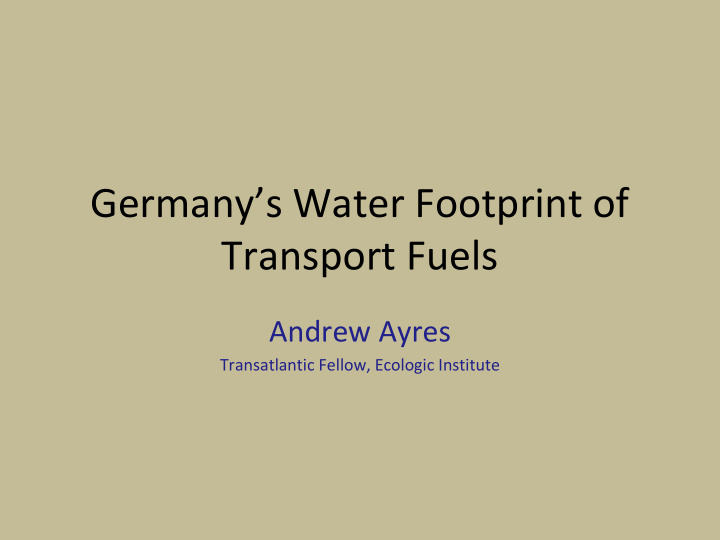



Germany’s Water Footprint of Transport Fuels Andrew Ayres Transatlantic Fellow, Ecologic Institute
Introduction Biofuel Expansion Water Management – – Climate Agriculture largest water – Energy Security consumer – Targets set – Multiple across the globe stressors on – Focus lies quantity and mainly still on quality first-generation – Water biofuels footprinting
Background • Directive 2009/28/EC – 10% of all energy used in transport must come from renewable sources – Denominator includes petrol, diesel, biofuels, and electricity • Concerns regarding sustainability of biofuels – ILUC contributes to worsened GHG balance (IPCC, 2011; Schroten et al., 2011) – Water use requirements present challenge (IPCC, 2011) – Nachhaltigkeitsverordnung should address these
Research Rationale Source: Gerbens-Leenes and Hoekstra, 2011 “After consulting the author Hoekstra, it has become clear that the numerical values before the measuring unit Gm 3 /yr are meant to designate km 3 /yr = 10 9 m 3 /yr.” (Schubert, 2011)
Research Rationale • More specific and more accurate data for: – Transport fuel demand – Feedstock sources – Regional production Will allow for better picture of water footprint in German transport fuel sector • Trade sensitivity analysis explores implications of importing biofuels from abroad (Özdemir et al., 2009)
Water Use and Biofuels • German water withdrawals in 2007: over 20% of renewable resource (FAO, 2011) – Water stress by some definitions – Transport sector is today relatively water efficient • Water is a regional resource – Effects in and outside of Germany clearly of interest – Meeting global biofuel targets could require additional 262 km 3 of freshwater (de Fraiture et al., 2007) • Countries like China and India, among others, at risk of increased regional water scarcity
The Water Footprint Source: WF Assessment Manual (Hoekstra et al., 2011)
The Water Footprint • Multidimensional indicator for capturing water use in production processes, countries, economic sectors – Comparing process efficiency – Position relative to consumption boundaries – Illuminating international resource distribution • Lacking, however, as a policy tool – No operational definition of sustainability built into tool – Dynamically weak – Weak across borders – Lack of pricing ignores comparative advantage
Methodology • Transport Demand – Projection of German transport energy demand in 2020 (Eichhammer, 2000) – Reflects falling trend in German transport fuel demand over last 10 years (Eurostat, 2012) • Feedstock Sources – Domestic weighted by feedstock type (VDB, 2011) • Bioethanol: 2/3 Cereals, 1/3 Sugar Beets • Biodiesel/Plant Oil: 100% Rapeseed (Canola Oil) – Domestic and international footprints from Mekkonen and Hoekstra (2010) • Regional Production – Regional data on feedstock production weights domestic water footprints (from various German government agencies) – International export countries (Özdemir et al., 2009)
Methodology Production Regions - Largest producers not necessarily those with largest WFs - Imported sources tend to have higher WFs
Results
Results • Vary significantly from results of Gerbens- Leenes and Hoekstra (2011) [8 vs. 22.26 km 3 ] • Policy scenario increase represents 7% of 117.6 km 3 total German water consumption for agriculture • Trade scenarios show overall increase in footprint, but in different environmental contexts – Weakness of WF as indicator – Domestic feedstocks tend to have higher grey footprints
Results • Assumptions of Gerbens-Leenes (2011) – Energy use in 2020 • Equivalent to 2005 values – Fuels used • Most water efficient feedstocks and fuels available – German market currently supplied with 70% biodiesel – Footprint of non-biofuel road fuels • Ignore petroleum and diesel WFs
Conclusions • Water footprint can only serve as guidepost in assessing policy • Scarcity-adjusted management practices are necessary in order to avoid water resource misallocation • Nonetheless, this analysis confirms that the water requirements of this legislation are significant and calls into question further expansion of first-generation biofuels
Questions, Comments? THANK YOU FOR YOUR ATTENTION! Andrew Ayres: andrew.ayres@ecologic.eu
Recommend
More recommend